A Review of the Two Mounds
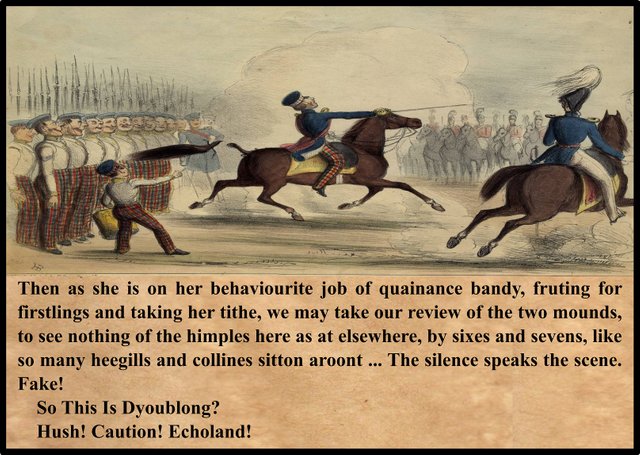
As I have said several times before, the opening chapter of Finnegans Wake is preludial. If Finnegans Wake were an opera, this chapter would be the overture that is played before the curtain rises. Everything in this chapter should be read as a foreshadowing of some salient moment that will be played out in a subsequent chapter. Pages 009-012 in The Restored Finnegans Wake, which we are currently studying, foreshadow Book I, Chapter 5 (RFW 083-099), The Mamafesta, which is essentially a commentary on ALP’s famous Letter to HCE. These pages also foreshadow a section of the book’s concluding chapter in which we finally get to hear the Letter in full—one version of it, at any rate (RFW 481.28-485.10).
But I believe that the third paragraph of this section also anticipates III.4, The Fourth Watch of Shaun, in which the lovemaking of ALP and HCE is portrayed in operatic terms—or possibly as a silent movie with incidental musical. As we shall see, there is a clear musical theme running through these eighteen lines of text.
First Draft
Joyce’s first draft of this section is very brief, comprising only the beginning and ending:
The best plan is to tour round east & north & review the two mounds. Pardon. Behold this sound of Irish sense. Really? Here English might be seen. Royally? . . . . . . . . . . punned to paltry pence. Regally? A silence makes a scene. Behold!
Hush! Caution! Echoland! (Hayman 52)
The most notable thing about this early draft is the manner in which Joyce conflates the two senses of sight and sound: review ... Pardon ... Behold ... sound ... sense ... English ... seen ... punned ... silence ... scene ... Behold! ... Hush! ... Echoland!
This certainly makes sense in the overall context of ALP’s Letter: a written text is something that can be both seen and heard. The Letter is dictated by ALP, indited by her son Shem the Pen, and delivered by her son Shaun the Post.
Furthermore, in Finnegans Wake some characters are depicted as having a good eye and a poor ear while others have poor eyesight but good hearing. HCE’s name contains the word ear (but is his “ear weaker”—Earwicker?), while Shem, like his alter ego James Joyce, has poor eyesight but a good ear for music. Issy is sometimes characterized throughout the book by her “eyes” (-ii-), and spends much of the time admiring her reflection in the mirror.
In the preceding passage, we left the gnarlybird—who represents ALP, Issy and Kathe—rooting among the kitchen midden behind The Mullingar House, but the present passage shifts our attention to the Phoenix Park, which also lies behind The Mullingar House. This is clear from Joyce’s allusion to a piece of humorous verse by Jonathan Swift:
Behold! a proof of Irish sense;
Here Irish wit is seen!
Where nothing’s left, that’s worth defence,
We build a magazine.
(Swift et al 228)
Swift was poking fun at the Magazine Fort, an elaborate bastion fort that was constructed on Thomas’ Hill in the Phoenix Park in 1735. Swift’s godson Thomas Sheridan recounted how this epigram came about:
The dean, in his lunacy, had some intervals of sense; at which time his guardians or physicians took him out for the air. On one of these days, when they came to the Park, Swift remarked a new building, which he had never seen, and asked what it was designed for. To which Dr. Kingsbury answered, “That, Mr. dean, is the magazine for arms and powder, for the security of the city.” “Oh! oh!” says the dean, pulling out his pocketbook, “let me take an item of that. This is worth remarking: ‘my tablets,’ as Hamlet says, ‘my tablets—memory, put down that!”—Which produced the above lines, said to be the last he ever wrote. (Swift, et al 228 fn)
Hamlet actually calls for his tables, not his tablets (Hamlet 1:5:107). It is curious that Stephen Dedalus makes the same mistake in the Proteus episode of Ulysses, which leads one to suspect that Joyce was drawing on Swift (or perhaps Sheridan) rather than Shakespeare.
Swift was also the author of Gulliver’s Travels, whose iconic image of Gulliver as a sleeping (dormont) giant on the Lilliputian shore informs the whole of this opening chapter of Finnegans Wake.

Revue des Deux Mondes
What, then, are the two mounds in the context of Finnegans Wake:
The two worlds, the Old World and the New World (French: monde, world).
The two butt cheeks of HCE’s arse as he and ALP have sex.
ALP’s two breasts.
HCE and ALP in bed together.
The two halves of the Phoenix Park, with Chesterfield Avenue running down the middle.
Two prominent hills on the Battlefield of Waterloo: Mont St Jean, where Wellington was stationed, and Hougoumont, where the French assault met with dogged resistance. Or perhaps the Lion’s Mound, which was constructed after the battle.
HCE’s head and feet, which are sticking up under the puzzle quilt as he lies abed.
The Revue des Deux Mondes [Review of the Two Worlds] is a monthly French literary, cultural and political magazine that has been in continuous circulation since 1829.
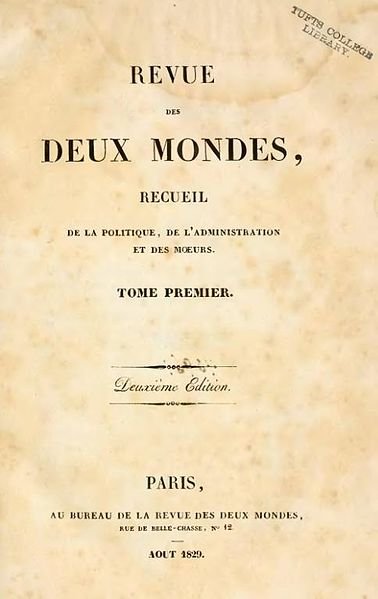
Military Review
In this context, the word review suggests to me a military review. This entire paragraph can be read as a description of a military review in the Phoenix Park, with a military band playing martial music. This continues the bellicose theme that has been prominent in this chapter since the Museyroom Episode—if not earlier (RFW 003-23: What clashes here ...). In fact, the Museyroom Episode can now be seen retroactively as a reenactment of the Battle of Waterloo rather than the real thing—but in a book like Finnegans Wake is there any difference?
Military reviews were regularly held in the Phoenix Park in the 18th, 19th and 20th centuries. One of Lady Morgan’s novels, The O’Briens and the O’Flahertys, features a military review of the Irish Volunteers in the park some time during the 1770s (Volume 1, Chapters 3-4):
They [the Irish Volunteers] continued to hold their military reviews in all parts of the kingdom [of Ireland], and their graceful movements, performed under the rewarding eye of beauty, were executed to the exhilarating sounds of their national music. Such meetings were considered as historical epochs by the people, and such reviews were regarded as national festivals ... and their reviews continued to embrace all classes, either as actors or spectators, from the viceroy to the lowest populace. (Morgan 143 ... 146)
In the course of the military review which Lady Morgan describes in—one of the last and the most splendid (Morgan 147)—a mock combat or sham fight (Morgan 201) is fought over the Star Fort. This elaborate structure was raised in 1710 by the military engineer Thomas de Burgh at the behest of the Lord Lieutenant of Ireland Thomas Wharton, who feared a possible uprising of the local populace. It lay just a few hundred metres northeast of Thomas’ Hill and was demolished in 1837. Like the Magazine Fort, this building was also the subject of local ridicule, being known as Wharton’s Folly:
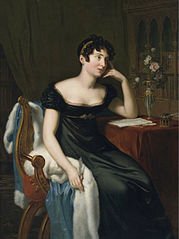
The spot chosen for this display of calculated evolutions, was called the Star Fort, the attack and the defence of which formed the principal features in the manoeuvres of the day. It appeared the ruin of a strong and ancient hold, covering a regular polygon, of considerable dimensions; but was, in reality, of modern construction. It was raised by the celebrated Earl of Wharton as a retreat for safety in the event of an insurrectionary movement in the capital—some symptoms of such an event having manifested themselves in an attack upon the statue of King William the 3rd, on his lordship’s arrival in the country, to take the reins of its government. But the apprehensions it had awakened proved groundless; the Fort, ere it was quite finished, was permitted to fall into a picturesque and premature decay, (presenting to the eye the image of a once impregnable place; and adding to the fine scene, it dominated, a feature of characteristic interest and great effect,) and it continued to be long identified with the reign of him who erected it, by the name of “Wharton’s Folly.” (Morgan 193-194)
It is possible that Joyce mistook Wharton’s Folly for the Magazine Fort. Adaline Glasheen certainly thought so:
Wharton, Thomas, Marquis of (1648–1715)—author of “Lilliburlero.” When
he was viceroy (q.v.), Dublin Castle, O’Mahony says, became “a glorified tavern and brothel,” and in the Phoenix (q.v.) Park was built the Star Fort, locally known as “Wharton’s Folly.” It is my impression that in I,i, Joyce assumes “Wharton’s Folly” to be the Magazine (see Wall, Maggies), which erection caused Swift to say: “Where nothing’s left that’s worth defense ...” (FW 12–13). 12.23; ?269.12. (Glasheen 304)
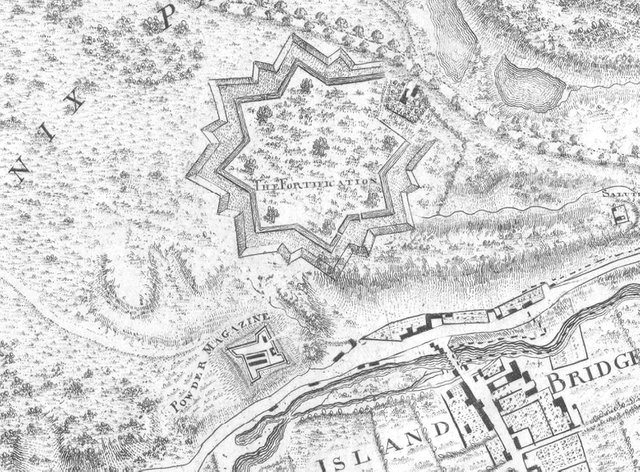
It is equally possible, however, that Joyce simply conflated the two structures for artistic reasons. In his Paris-Pola Commonplace Book, a notebook he compiled around 1903-04 in Paris and Pola, he drew up a list of writers of fiction—presumably ones he intended to read. Lady Morgan takes pride of place on this list. Joyce must have been familiar with her work, though I do not know whether he ever read The O’Briens and the O’Flahertys.
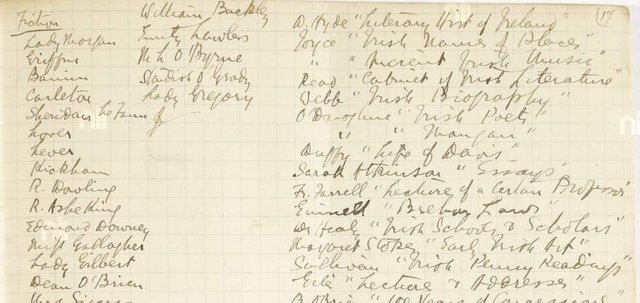
Note also that the cartographer John Rocque refers to the Star Fort and the Magazine Fort as The Fortification and Powder Magazine respectively. Is Joyce referring to these in the passage:
as he lays dormont from the macroborg of Holdhard and the microbirg of Pied de Poudre. (RFW 010.31-32)
Of course, the primary sense here is once again the image of HCE interred in the Irish landscape, with his head representing Howth Head (Holdhard) and his feet (French: pied, foot) representing Castleknock. But this does not mean that other interpretations are not also present. Lady Morgan refers to the Star Fort as a hold, and we have the French: poudre, gunpowder. In hindsight, we might conclude that the two mounds are simply the two hills on which these fortresses stood.
The remainder of this paragraph is primarily concerned with the music that accompanies the military evolutions, which we will look at—or, rather, listen to—in the next article in this series.

References
- Adaline Glasheen, Third Census of Finnegans Wake, University of California Press, Berkeley CA (1977)
- David Hayman, A First-Draft Version of Finnegans Wake, University of Texas Press, Austin TX (1963)
- James Joyce, Ulysses, Shakespeare & Company, Paris (1922)
- James Joyce, Finnegans Wake, The Viking Press, New York (1958, 1966)
- Lady Morgan, The O’Briens and the O’Flahertys: A National Tale, Volume 1, Henry Colburn, London (1827)
- Danis Rose, John O’Hanlon, The Restored Finnegans Wake, Penguin Classics, London (2012)
- [William Shakespeare, Horace Howard Furness (editor]](https://archive.org/details/newvariorumediti11shak/page/107), A New Variorum Edition of Shakespeare: Hamlet, Volume 1, J B Lippincott Company, Philadelphia & London (1918)
- Jonathan Swift, Thomas Sheridan, John Nichols, The Works of the Rev. Jonathan Swift, D.D., Volume 8, J Johnson, J Nichols et al, London (1801)
Image Credits
- A Field Day in the Phoenix Park: W Kohler (printer), Public Domain
- Revue des Deux Mondes: Wikimedia Commons, Public Domain
- Lady Morgan: René Théodore Berthon (artist), National Gallery of Ireland, NGI 133, Public Domain
- The Magazine Fort: © Dronepicr, Creative Commons License
- The Star Fort on John Rocque’s Map of 1757: John Rocque (cartographer), Bibliothèque nationale de France, Public Domain
- Joyce’s Paris-Pola Commonplace Book: National Library of Ireland, The Joyce Papers 2002, c.1903-1928, MS 36,639/2/A, Fair Use
- The Phoenix Park: © The Office of Public Works, Fair Use
Useful Resources
- Joyce Tools
- FWEET
- The James Joyce Scholars’ Collection
- FinnegansWiki
- James Joyce Digital Archive
- Annotated Finnegans Wake (with Wakepedia)
- From Swerve of Shore to Bend of Bay

very good post my dear..